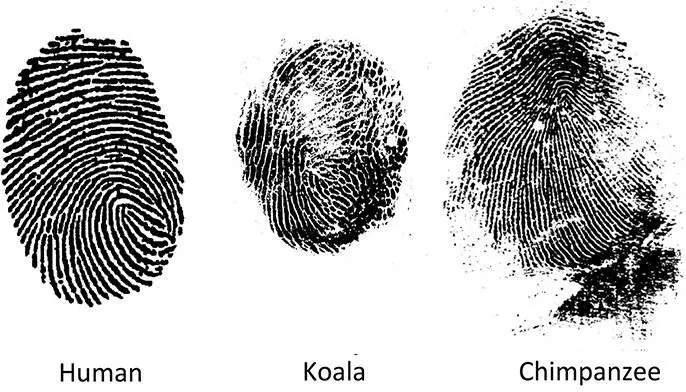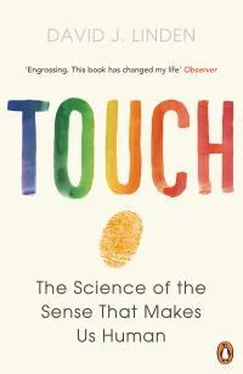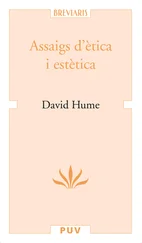
Figure 2.1The structure of glabrous and hairy skin share a similar layered pattern but have some important differences as well.
As a symbol, fingerprints have a deep emotional and spiritual resonance. There’s something fascinating about them—they’re an external mark of human individuality written in an obscure artistic code. Fetal fingerprints begin to form at about age twenty-six weeks and have already achieved their adult shape at birth. In the tradition of the Dineh people (also known as the Navajo), the Spirit Winds, a kind of life force, are said to emanate from fingerprints:
There are whorls here at the tips of our fingers. It is the same way on the toes of our feet and Winds exist on us here where soft spots are, where there are spirals … These Winds sticking out of the whorls at the tips of our toes hold us to the Earth. Those at our fingertips hold us to the Sky. Because of these, we do not fall when we move about. 8
That wonderful description is both moving and evocative. But from a biological point of view, what function do fingerprints (and palm, toe, and sole prints) serve? A long-standing hypothesis holds that they aid in climbing and grasping, but this notion has been challenged. When the friction between a fingertip and a smooth, dry surface was measured, it was found, counter to expectations, that fingerprints reduced grasping efficiency by about 30 percent. However, when a surface is wet or rough, fingerprints increase friction and stabilize grasp. In that respect they resemble automobile tires: Race cars, which encounter only smooth, dry racetracks, are fitted with smooth tires to maximize the contact area between tire and roadway and thereby provide maximum grip. Passenger cars, in contrast, are typically driven over wet and uneven surfaces, and in these conditions, tires with grooves cut to channel water away from the contact area are superior.
Fingerprints are not uniquely human: Gorillas and chimpanzees have them as well. Nor are they unique to primates. Fingerprints appear in a scattershot fashion throughout mammalian species. In Australia they are present in koalas, but not in a close relative of koalas called the hairy-nose wombat, or in another arboreal creature, the tree kangaroo. 9Fingerprints are found in fishers, a type of North American weasel, but not in some other members of the weasel family. At present it’s not certain if the presence of fingerprints in a particular species is related to its grasping behavior. For all their symbolic significance, we still don’t really know what fingerprints are for.

Figure 2.2Human, koala, and chimpanzee fingerprints are almost indistinguishable. The evolutionary paths of humans and koalas diverged at least 70 million years ago, yet humans and koalas share fingerprints, while other species that are close relatives of koalas do not. Reprinted from M. J. Henneberg, K. M. Lambert, and C. M. Leigh, “Fingerprint homoplasy: koalas and humans,” NaturalScience 1, article 4 (1997), with permission of Heron Publishing. Thanks to Dr. Maciej Henneberg, University of Adelaide, Australia.
I can still hear my mother’s voice: “Get out of the bath. You’re turning into a human prune!” Many people believe that the wrinkly finger and toe pads one gets from prolonged exposure to water are the result of a passive process in which water is gradually absorbed by the dead skin cells of the stratum corneum. However, this was shown to be false as early as 1936. 10The key observation regarding this phenomenon is that finger and toe wrinkling do not occur if the electrical signals flowing from the spinal cord to the skin are interrupted by cutting the nerve or applying a drug that blocks the nerve’s signals, manipulations that have no effect on the stratum corneum. In particular, the wrinkling response requires a branch of the subconscious autonomic nervous system called sympathetic outflow. 11
So what, if anything, is the purpose of the wrinkling response? Mark Changizi and his colleagues at 2AI Labs have suggested that, like fingerprints, the wrinkles function as rain treads to increase traction on wet surfaces. They note that the wrinkling response is also found in macaque monkeys and chimps and suggest that it may be an adaptation of primates to wet, slippery conditions. 12In support of this hypothesis, Kyriacos Kareklas and his colleagues at Newcastle University showed that subjects with wrinkled fingers were able to transfer wet marbles from one container to another at a significantly higher speed than subjects with unwrinkled fingers. Wrinkled fingers conferred no advantage in handling dry marbles, however. 13

How are the specialized touch sensors arranged in the skin, and how does this arrangement influence our tactile experience? This turns out to be a big question. To explore it, let’s take an everyday manual task and break it down into tiny steps. You’re running late for a movie and are relieved to find a parking place in the crowded streets around the theater. Standing in front of the old-style mechanical parking meter, you see that it takes only quarters. Fishing in your pocket of loose change and miscellaneous junk, you feel around until you find a quarter, extract it, and insert it in the meter’s slot. You then grip the handle and twist. As you twist you feel that satisfying action of the ratchet mechanism in the meter engaging, the ker-plink vibration of the quarter falling inside, and, finally, the twisting force as the handle counterrotates to return to its starting position.
This mundane task is something that we accomplish almost automatically, with very little mental effort, and yet it would defeat nearly all of the most sophisticated present-day robots in a real-life situation. This is a clue that even simple tactile-guided tasks require a rich stream of information (as well as expectations about the physics of our bodies and the outside world). In feeding the parking meter, we rely upon four main types of touch sensor and their associated nerve fibers embedded in the glabrous skin of the fingertips (figure 2.3).
As you begin rooting around in your pants pocket (or perhaps your purse or backpack) trying to identify a quarter by touch alone, you fondle a USB thumb drive, two sticky ibuprofen tablets, a dime, two pennies, and a nickel before you recognize a quarter based upon its size and the texture of its bas-relief faces and ridged edge. In this process, all four main types of touch sensor in the skin of your fingertips are active, but the key sensor that allows you to detect the edges of objects, local curvature, and rough texture is called a Merkel cell. It is named after the German anatomist Friedrich Merkel, who first described them in 1875, calling them Tastzellen, or “touch cells.” These specialized epidermal cells are found clustered in disks made up of several cells. The disks are located on the peaks of the primary epidermal ridges, at the border between the epidermis and the dermis (figure 2.3). A Merkel disk is contacted by a single nerve fiber that transmits information from the Merkel disk–nerve fiber junction in the skin to the spinal cord and, ultimately, the touch-sensing regions of the brain. This electrical information is encoded by brief changes in voltage lasting about one one-thousandth of a second, called spikes. 14One enduring question is how the mechanical energy of skin deformation is transformed into an electrical signal in the nerve ending. The best present hypothesis is that this is accomplished by a type of molecule embedded in the membrane of the nerve ending called a stretch-activated ion channel. These molecules form a pore that is closed at rest, but when the cell membrane is stretched the pore opens, allowing positive ions like sodium and calcium to flow into the nerve cell and thereby trigger an electrical spike. 15
Читать дальше















